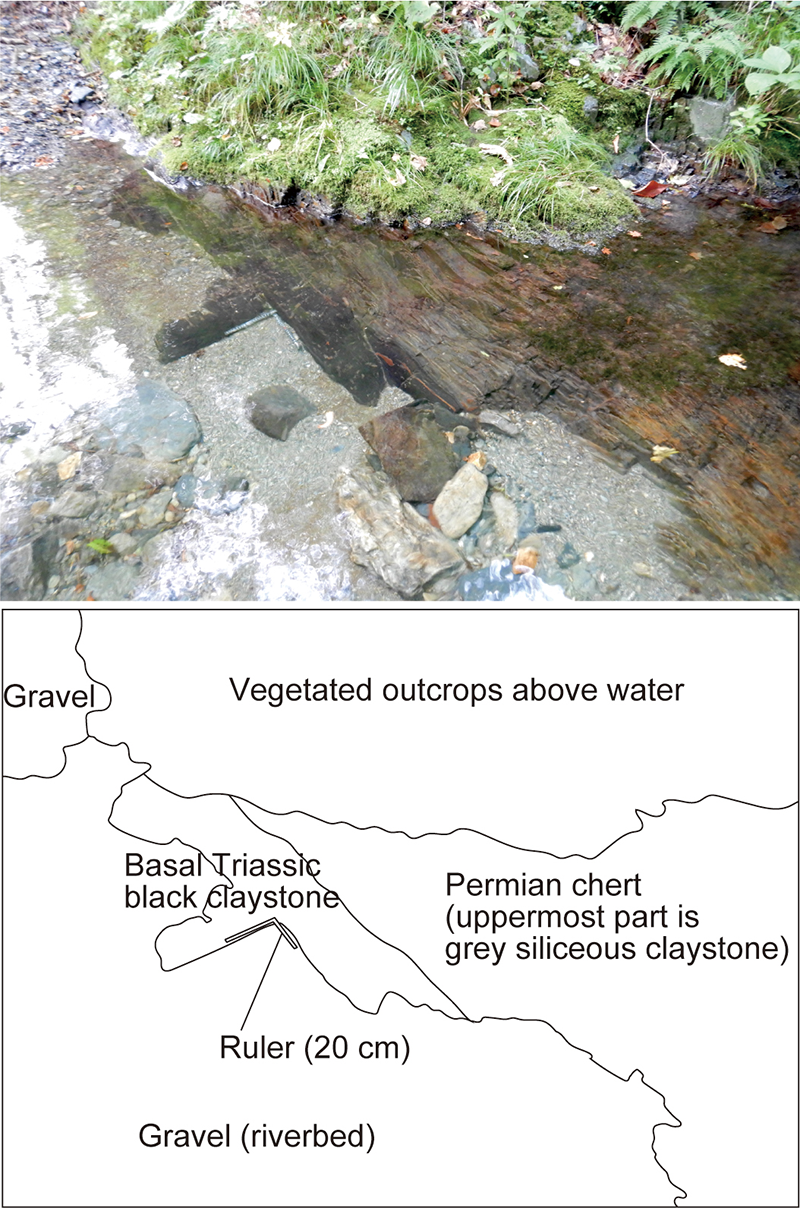Bulletin of the Geological Survey of Japan Top Page
Bulletin of the Geological Survey of Japan Vol.74 No.1 (2023)
Cover photograph | Table of Contents | Abstract
Cover photograph
Deep-sea Permian–Triassic boundary in the Okoshizawa Subunit (Figure is an outline sketch)
The Otori Unit of the North Kitakami Belt studied in this report includes in its structurally lower part pelagic deep-sea strata that includes the Permian–Triassic boundary. The boundary interval is composed of black claystone and siliceous claystone in which deformation of the deep-sea strata is typically concentrated. Therefore, this boundary is only known from several outcrops in Japan, despite the wide distribution of Jurassic accretionary complexes. The Otori Unit is an exceptional case, in which the Permian–Triassic boundary black claystone is traced laterally over a wide area. The outcrop along the Orikabe River in the photograph is one of the outcrops where this lithofacies is observed. As typical of this area, rock exposure is obscured by vegetation even by the streams, but a conformable relationship between Permian chert and basal Triassic black claystone is clearly seen underwater.
(Photograph and Caption by MUTO Shun)
Table of Contents
All the pages PDF : 74_01_full.pdf [24MB]
| Title | Author | |
|---|---|---|
| Article | ||
| Geology and accretionary age of the Otori Unit, North Kitakami Belt |
MUTO Shun, ITO Tsuyoshi and MURAYAMA Masafumi (p1-40)
|
74_01_01.pdf [21MB] |
| Abstract | ||
| Abstracts of the 34th GSJ symposium “Research of Earthquake, Tsunami, and Volcano at AIST toward disaster prevention and mitigation: Achievements of 10 years since the Great East Japan Earthquake and future research” |
Secretariat of the 34th GSJ Symposium (p41-60)
|
74_01_02.pdf[2.5MB] |
Abstract
Geology and accretionary age of the Otori Unit, North Kitakami Belt
MUTO Shun, ITO Tsuyoshi and MURAYAMA Masafumi
The North Kitakami Belt in Northeast Japan mainly comprises accretionary complexes formed during the Jurassic to earliest Cretaceous. The accretionary complex of the North Kitakami Belt is less studied compared to the age-equivalent accretionary complexes in Southwest Japan. Here, we provide additional data on the accretionary complex formerly classified as the Otori Unit, distributed in the northeastern part of the North Kitakami Belt in the upper reaches of the Akka River in Iwate Prefecture. Based on detailed field mapping, we clarified that the Otori Unit is composed of the structurally lower coherent facies of chert and siliceous mudstone (Okoshizawa Subunit) and the structurally upper mixed facies of mudstone, sandstone, chert and minor basaltic rocks (Osakamoto Subunit). Manganese nodules from siliceous mudstone within the Okoshizawa Subunit yielded radiolarians indicating the Bathonian (upper Middle Jurassic). Detrital zircon grains from sandstone in the Osakamoto Subunit has a youngest age of ~170 Ma (YC1σ: 171.8 ± 2.4 Ma; YSG: 170.9 ± 3.8 Ma). Based on the radiolarian and detrital zircon ages, the accretionary age of the Otori Unit is estimated as the Bathonian. Our new data were also considered to discuss the correlation between the North Kitakami Belt and the Southern Chichibu Belt in Southwest Japan. The Otori Unit corresponds to the Ohirayama Unit of the Southern Chichibu Belt in structural position, and the two units are similar in being a mixed facies and have overlapping accretionary age. However, the Otori Unit lacks limestone and has a considerably younger age for siliceous mudstone, suggesting that the two units may not be strictly correlative.
Geological Survey of Japan, AIST
- About GSJ
- Our Activities
- Purchase guide
-
Publications and Database
- information
- Bulletin of the Geological Survey of Japan
- bull2025(Vol.76)
- bull2024(Vol.75)
- bull2023(Vol.74)
- bull2022(Vol.73)
- bull2021(Vol.72)
- bull2020(Vol.71)
- bull2019(Vol.70)
- bull2018(Vol.69)
- bull2017(Vol.68)
- bull2016(Vol.67)
- bull2015(Vol.66)
- bull2014(Vol.65)
- bull2013(Vol.64)
- bull2012(Vol.63)
- bull2011(Vol.62)
- bull2010(Vol.61)
- bull2009(Vol.60)
- bull2008(Vol.59)
- bull2007(Vol.58)
- bull2006(Vol.57)
- bull2005(Vol.56)
- bull2004(Vol.55)
- bull2003(Vol.54)
- bull2002(Vol.53)
- bull2001(Vol.52)
- Bulletin of the Geological Survey of Japan(old)
- Annual Report on Active Fault and Paleoearthquake Researches
- Reports, Geological Survey of Japan
- CCOP-GSJ Groundwater Project Report
- CCOP Technical Bulletin
- Cruise Report
- Geological Hazards
- Learning and Education
- GSJ Database Collection
- Collection of links


